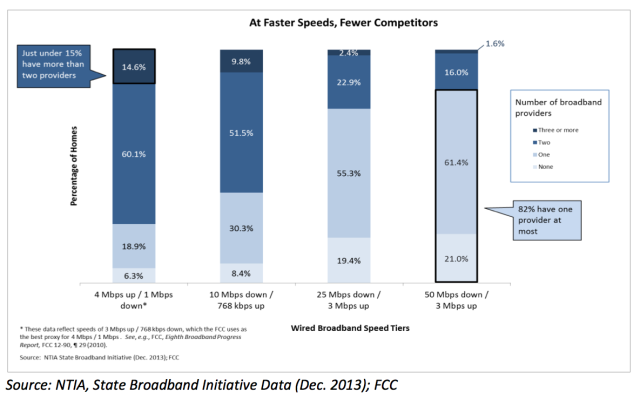
The Federal Communications Commission is scheduled to vote tomorrow on a change to the definition of “broadband” and in so doing could leave about a fifth of the country without access to service that meets the new minimum standard.
At today’s broadband definition of 4Mbps downstream and 1Mbps up, only 6.3 percent of US households have no access to wired broadband. That doesn’t mean the other 93.7 percent are using broadband, but they could buy it from at least one wired Internet provider in their city or town:

Under the proposed definition of 25Mbps down and 3Mbps up (which is opposed by Internet providers), 19.4 percent of US households would be in areas without any wired broadband providers. 55.3 percent would have just one provider of “broadband,” with the rest being able to choose from two or more. Rural areas are far less likely to have fast Internet service than urban ones.
In FCC parlance, broadband is "advanced telecommunications capability" that "enables users to originate and receive high-quality voice, data, graphics, and video telecommunications using any technology." The FCC determines a minimum speed.
Among the major wired Internet providers, a change in definition would disproportionately affect DSL service. Cable generally has no problem delivering 25Mbps; Comcast’s standard lineup does include an entry-level tier that goes up only to 6Mbps downstream, but its higher-priced tiers are advertised at 150Mbps down and 20Mbps up. Fiber networks also meet the proposed broadband definition with ease, with some offering a gigabit in both directions. (As always, speeds are "up to" the advertised numbers and don't always hit them.)
It’s a different story for DSL, which is delivered over copper telephone lines. Bitrates decline over distance, so customers receive fewer bits per second if they’re far away from distribution points, but even under ideal circumstances DSL generally won’t provide 25Mbps service.
This means a big portion of AT&T and Verizon subscribers will no longer have “broadband” if the FCC changes the definition. The nation’s two largest traditional telephone companies have each deployed a lot of fiber, but still have plenty of DSL customers.
AT&T has 16 million wired Internet subscribers, of which nearly 4 million are on DSL. AT&T’s “Elite” DSL service goes up to 6Mbps downstream under ideal conditions and costs $35 a month for the first six months. AT&T also offers lower tiers of 768Kbps and 3Mbps.
The other 12 million AT&T customers get faster speeds, though not necessarily 25Mbps. AT&T’s fiber-to-the-home service can hit a gigabit, but it’s deployed in fewer areas than AT&T’s U-verse fiber-to-the-node networks. These hybrid networks bring fiber to distribution points within 600 to 900 meters from homes and deliver data over copper the rest of the way. This brings service of 45Mbps down and 6Mbps up, but that highest speed is not available in all of AT&T’s fiber-to-the-node territory because of technology limitations. Slower fiber-to-the-node tiers fall short of 25Mbps.
AT&T says it will eventually upgrade its top fiber-to-the-node tiers to 100Mbps downstream. AT&T did not tell Ars what percentage of its fiber-to-the-node deployments can support at least 25Mbps/3Mbps today.
Verizon had 9.2 million Internet customers at the end of 2014, of which about 6.6 million have FiOS fiber-to-the-home service, according to the company's latest earnings report. The rest would be on DSL.
Verizon’s maximum DSL speed is 15Mbps down and 1Mbps up. “We currently do not have any plans to enhance that,” a Verizon spokesperson told Ars.
FiOS starts at 25Mbps down and 25Mbps up for $55 a month, and nearly 60 percent of FiOS customers subscribe to at least 50Mbps service, according to Verizon. Verizon's top service is 500Mbps in both directions, for $285 a month.
UPDATE: One reader tells us that Veirzon is selling slower speeds in some FiOS areas:
@jbrodkin Article Correction: I pay $85 a month for Fios at 20/5 and I live in a major city. Goes as low as 3/1 pic.twitter.com/l3BgyTqnmK
— Brothernod (@Brothernod) January 29, 2015
In response, a Verizon spokesperson told Ars that "3/1 is not a general market offering today. Those customers who have it could likely be grandfathered in. And the 20/5 is very likely the same scenario, or they could be served by in a MDU [multiple dwelling unit] with specialized equipment."
CenturyLink, the third largest phone company, has 6 million Internet subscribers and has been upgrading parts of its territory to fiber. CenturyLink doesn't report how many of its customers are on DSL, Bruce Leichtman of Leichtman Research told Ars.
CenturyLink offers gigabit service with fiber-to-the-home, and up to 40Mbps with a fiber-to-the-node deployment similar to AT&T's. The company's slower tiers range from 1.5 to 20Mbps downstream. "We currently offer 40Mbps and higher speeds to 25 percent of our customer base," CenturyLink told Ars. "We also offer broadband speeds of 100Mbps and 1Gbps in several parts of the country. A customer’s proximity to a central office for subscribing to 25Mbps speed and above varies depending upon the technology available in the market."
DSL isn't dead
Though cable and fiber provide the best home Internet options for consumers today, that doesn’t mean DSL has no future. There’s a lot of copper deployed throughout the US, and, given the expense of bringing fiber to every home, it shouldn’t go to waste. A new DSL standard called G.fast promises to bring gigabit speeds to fiber-to-the-node networks, but it operates at higher frequencies than today’s DSL, requiring shorter transmission distances. That means network operators will have to bring fiber closer to homes, but would avoid the expense of wiring up each individual building.
Changing the broadband definition won’t force providers to give all Americans better service, but the FCC can require minimum speeds in certain scenarios. Ignoring objections from AT&T and Verizon, the FCC recently ruled that companies accepting Universal Service funds from the government to build in rural areas must provide at least 10Mbps down and 1Mbps for those deployments.
Setting the broadband bar higher, at 25Mbps/3Mbps, serves to shame US providers and give the FCC more reason to take actions like preempting state laws that prevent cities and towns from building their own broadband networks. A new definition will also help FCC Chairman Tom Wheeler argue his case that there isn’t enough broadband competition; while most Americans can choose from at least two “broadband” providers under today’s definition, most would have only one broadband option under the proposed higher standard. Customers will still have the same speeds they had today, but the new definition would better reflect the perception that broadband customers don’t have enough choices.
reader comments
221